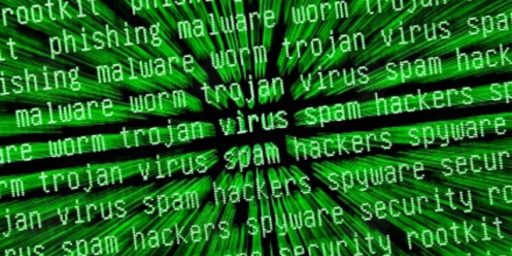Stuxnet Infects Russian Nuclear Plant, And The Space Station
Apparently, the Stuxnet virus, which was designed, apparently by U.S. and Israeli intelligence, to disable the centrifuges that Iran uses to purify nuclear fuel, has made it into orbit:
A Russian nuclear power plant was reportedly “badly infected” by the rogue Stuxnet virus, the same malware that reportedly disrupted Iran’s nuclear program several years ago. The virus then spread to the International Space Station via a Stuxnet-infected USB stick transported by Russian cosmonauts.
Speaking to journalists in Canberra, Australia, last week, Eugene Kaspersky, head of the anti-virus and cyber protection firm that bears his name, said he had been tipped off about the damage by a friend who works at the Russian plant.
Kaspersky did not say when the attacks took place, but implied that they occurred around the same time the Iranian infection was reported. He also did not comment on the impact of the infections on either the nuclear plant or the space station, but did say that the latter facility had been attacked several times.
The revelation came during a question-and-answer period after a presentation on cyber-security. The point, Kaspersky told reporters at Australia’s National Press Club last week, was that not being connected to the Internet — the public web cannot be accessed at either the nuclear plant or on the ISS — is a guarantee that systems will remain safe. The identity of the entity that released Stuxnet into the “wild” is still unknown (although media speculation insists it was developed by Israel and the United States), but those who think they can control a released virus are mistaken, Kaspersky warned. “What goes around comes around,” Kaspersky said. “Everything you do will boomerang.”
(…)
Now that the plague has been unleashed, said Kaspersky, no one is immune — and that includes its originators, who are no longer in control of it. “There are no borders” in cyberspace, and no one should be surprised at any reports of a virus attack, no matter how ostensibly secure the facility, he said.
That, of course, is the danger with any kind of cyber warfare. Once the methods are out there, they are capable of being copied by anybody and turned against the people who originated the attack. Perhaps that’s a reason to be careful of what we’re doing here.
H/T GeekPress







And that’s just Stuxnet. Imagine the damage a virus with a broader spread of potential targets could do.
There is a lot of talk about pandemics but in this technological dependent civilization I think it will probably be a computer virus that kills us all.
I wouldn’t discount disinformation, but if true, the Russians have a right to be angry.
Stuxnet is a kit for attacking certain Siemans industrial controllers. The original version was targeted at a specific installation, the Iranian centrifuges. An infection by original Stuxnet of any system not controlled by the Siemans controllers or not matching the target profile, will not do any real damage to that system. In fact, the article does not state any damage beyond the actual presence of the virus. The problem is that Stuxnet is easily modified to attack other sites using the same controllers. A lot of proprietary knowledge is necessary to write a virus to attack the controllers, and that knowledge was unknown outside of the company and some government entities before the release of Stuxnet. Now, any script kiddie that has a copy of Stuxnet can attack these systems. Subsequent viruses released by the Israelis and US contained a self destruct mechanism, but even those have left copies in the wild.
The real danger of cyber war is that when you attack you give your enemy a weapon he can then use against you.
@RWB: I worry more about the brilliant independent computer savy sociopaths and psychopaths.
@RWB:
*This*
The nature of digital is towards abundence – hence its near impossible to make a digital weapon that can both do it’s job and *not* destroy itself. The net result is essentially a reusable nuke.
@Ron Beasley:
Actually, my worry is slightly different – I’m not worried about the *brilliant* computer savy sociopath. I’m worried about the sorta-smart script kid who graduates from running botnets on other folks code to disseminating more potent (yet freely available) viruses developed by governments.
Based on how things have worked on the net, this seems the far more likely way the modern technological world “ends.”
Though, xkcd, as always has a useful reminder on any technological hysteria:
http://xkcd.com/1289/
I think the worst virus age happened when Microsoft operating systems intended for a single isolated user met the Internet. They didn’t even have log-in or user identity for goodness sake.
Since then the “immune system” and “viruses” have co-evolved.
I think that makes it much less likely for a “big whammy” to occur.
Most of us live now behind many layers of defenses.
@john personna:
Actually, the first virus infected floppy disks on the Apple II. Every time you formatted an new disk, you spread the infection.
@rwb:
Hmm. Not that I discount those floppy viruses and their (slow) impact and propigation among microcomputer users …
Computer Virus – Historical Development.
Deep roots.
(Really, note that I said “worst virus age” not earliest, and the earliest really were internet (arpanet) worms, not apple ii programs.)
@john personna: It wasn’t just microsoft by any means.
@Matt:
I didn’t say “only” or “just” either.
I said that was the biggest thing, when the wave of millions upon millions of unprotected MS systems hit the internet.
It was the biggest such influx.
@john personna:
from the link you site Computer Virus – Historical Development.:
In 1982, a program called “Elk Cloner” was the first personal computer virus to appear “in the wild”—that is, outside the single computer or lab where it was created.[69] Written in 1981 by Richard Skrenta, it attached itself to the Apple DOS 3.3 operating system and spread via floppy disk.[69][70] This virus, created as a practical joke when Skrenta was still in high school, was injected in a game on a floppy disk. On its 50th use the Elk Cloner virus would be activated, infecting the personal computer and displaying a short poem beginning “Elk Cloner: The program with a personality.”
Like or Dislike: Thumb up 0 Thumb down 0
@john personna: Except that isn’t really true. People were well aware of viruses well before the internet became a huge thing. Virus protection was already a big business before the internet boon so there weren’t millions of unprotected MS systems hitting the net. The systems were protected but protection only amounts for so much. Even the addition of UAC didn’t help as people will just click yes to the extra box that pops up. Can’t protect against stupid (every OS is vulnerable to that).
XP brought about a firewall built into the OS in 2001 which is when the internet started picking up. 98se had lesser levels of protection and it came out earlier.
The first real big worms and stuff didn’t hit until well after XP came out.
According to this Stuxnet attacks the Siemens’ industrial controllers operating system (SCADA) through Windows or Linux. The Siemens industrial controllers are everywhere and the latest versions of SCADA operate on the cloud.
@Ron Beasley: the latest versions of SCADA operate on the cloud.
*boggle*
@RWB:
What the heck’s the matter with you? You skip the early history, hoping that no one can comprehend that link?
Gosh, what came first, 1970 or 1980 …
@Matt:
You keep moving the ball.
There were more millions of computers infected when MS computers came onto public networks than ever before.
Truth.
The claim was not about “people being aware.”
It is in reality a nice and helpful piece of info. I am happy that you just shared this helpful information with us. Please keep us informed like this. Thank you for sharing.|